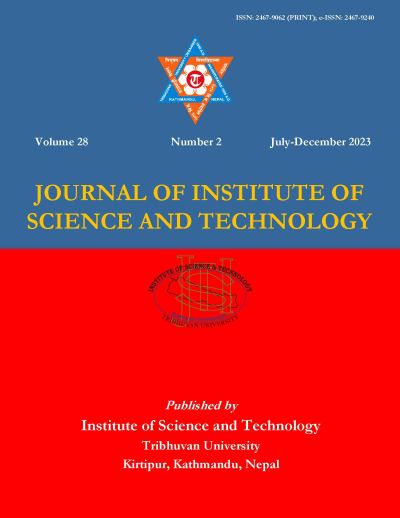Evaluation of Antioxidant, Antidiabetic, and Cytotoxic Activities of Lilium nepalense D. Don
DOI:
https://doi.org/10.3126/jist.v28i2.61174Keywords:
Antidiabetic, Brine shrimp, Bulb, DCM, IC50, LC50Abstract
Lilium nepalense, a temperate medicinal plant, is used as a diuretic, antipyretic, tonic, flavoring agent, and heart pain treatment. This research aimed to evaluate the in vitro antioxidant and antidiabetic activities of the methanol, dichloromethane (DCM), and hexane fractions, and in vivo cytotoxic activities of the crude extracts of the bulb. The antioxidant activity was assessed by 2,2-diphenyl-1-picrylhydrazyl (DPPH) assay, antidiabetic activity by α-glucosidase inhibitory assay, and cytotoxic activity in terms of LC50 (median lethality concentration) by Brine shrimp assay. The DCM fraction showed the strongest antioxidant activity (IC50=134.99±9.75 µg/mL) and highest antidiabetic activity (IC50=182.01±20.50 µg/mL) than other fractions. Similarly, the DCM fraction had the highest total phenolic contents (243.97±33.78 mg of gallic acid equivalent per gram dry weight) and highest flavonoid contents (7.68±0.85 mg of quercetin equivalent per gram dry weight) than other fractions. Moreover, the crude extract of the bulb was not found to be cytotoxic to the Brine shrimp nauplii (LC50=3.83 mg/mL). It is the first report to date describing the antioxidant, antidiabetic, and cytotoxic properties of L. nepalense. This study concludes that the DCM fraction of the bulb could be used as an antioxidant and antidiabetic agent for therapeutic purposes; however, further identification and characterization of bioactive compounds responsible for the antioxidant, antidiabetic, and cytotoxicity is required for further validation.
Downloads
Downloads
Published
How to Cite
Issue
Section
License
Copyright (c) 2023 Institute of Science and Technology, T.U.

This work is licensed under a Creative Commons Attribution-ShareAlike 4.0 International License.
The views and interpretations in this journal are those of the author(s). They are not attributable to the Institute of Science and Technology, T.U. and do not imply the expression of any opinion concerning the legal status of any country, territory, city, area of its authorities, or concerning the delimitation of its frontiers of boundaries.
The copyright of the articles is held by the Institute of Science and Technology, T.U.




